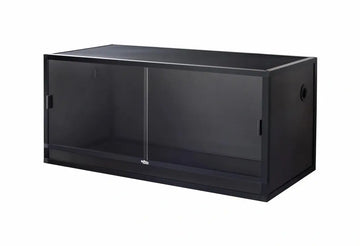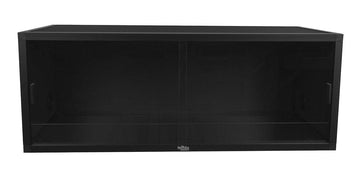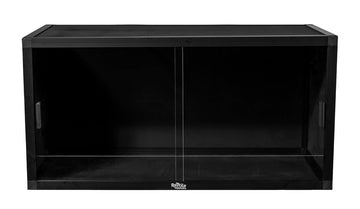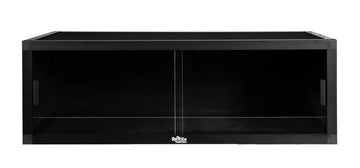Rhino rat snakes (Gonyosoma boulengeri) are 4-5’ long, arboreal snakes primarily found in China and north Vietnam. They generally prefer a moist forest habitat with nearby access to a body of water.
Rhino rat snakes have slender bodies, elongated pointed heads, slightly elliptical pupils, smooth scales. They’re best known for the horn-like point at the tip of their snout. This species is best known for their olive to bright green adult coloration, but they actually look different as babies: silver or gray-brown with a black, white, and/or yellow pattern. Adults are generally patternless, although they do retain a black stripe from nose to ear on both sides.
Rhino rat snakes aren’t the best choice of reptile for someone who wants to handle their pet on a regular basis, but their unusual appearance and bright green color does make this species an excellent display animal. With appropriate care, a rhino rat snake can live 15-20 years.
Minimum terrarium size for rhino rat snakes
The absolute minimum terrarium size for a single rhino rat snake is 5’L x 2.5’W x 2.5’H. Of course, larger is always better! Rhino rat snakes may look small due to their slender bodies, but the fact is that they still need enough room to stretch out fully, explore, and hunt.
Cohabitation (keeping multiple rhino rat snakes in one enclosure) is not recommended.
Do rhino rat snakes need UVB?
Technically they can survive without it, but we still recommend providing appropriate UVB lighting to rhino rat snakes. UVB lighting helps provide a clear day/night cycle, provides all of the vitamin D that your pet needs, strengthens the immune system, facilitates better digestion, and provides other benefits. Plus, it’s quite likely that they are regularly exposed to low levels of sunlight in the wild, due to the nature of their habitat.
The best UVB bulbs for rhino rat snakes in a 2.5’ tall enclosure are:
- Zoo Med Reptisun T5 HO 5.0
- Arcadia Forest 6%
For best results, use a UVB bulb roughly half the length of the enclosure and housed in a reflective fixture by Vivarium Electronics or Arcadia. Position the lamp on the same side of the terrarium as the heat lamp, about 9-11” above the basking branch and protected by mesh.
UVB is blocked by glass and plastic, so placing the terrarium in front of a window doesn’t count as “free UVB” — in fact it can make your terrarium too hot due to the greenhouse effect. Don’t forget to replace your bulb every 12 months!
It is also recommended to install a 6500K T5 HO fluorescent or LED grow light to span most of the enclosure’s length. This is essential for facilitating healthy plant growth if you are using live plants, and also helps create a distinct day-night cycle.
Lights should be on for 13 hours/day during summer and 11 hours/day during winter.
Best temperature for rhino rat snakes
Like other reptiles, rhino rat snakes are cold-blooded, which means that they rely on external temperatures to manage their own body temperature and metabolism. A reptile’s enclosure should offer a range of temperatures to allow them to thermoregulate effectively.
Specifically speaking, rhino rat snakes should have a basking surface temperature between 90-95°F. In the lower levels of the enclosure, the temperature should be 75-80°F. Temperatures should drop at night, but no lower than 70°F. You can check your temperature gradient by placing one digital probe thermometer on the basking surface and another in the shade on the other side of the enclosure.
Provide heat for your snake with a cluster of at least two incandescent heat bulbs, placed close together over the basking area (ex: a piece of flagstone or stone paver) to evenly heat the snake’s entire body. Do not use ceramic heat emitters (CHEs), red bulbs, or blue bulbs, as these are not as effective. If the bulbs are a little too hot, use a plug-in lamp dimmer to reduce output. If the bulbs are not hot enough, you will need a higher wattage.
Best humidity levels for rhino rat snakes
Rhino rat snakes are a tropical species that requires humidity levels between 50-100%, with an average around 75%. Humidity should be at the lower end of this range during the day, and higher at night. You can measure humidity with a digital probe hygrometer, with the probe placed in the middle of the enclosure.
Increase humidity by misting your snake’s enclosure 1-2x/day with a spray bottle. Mist first thing in the morning and then again at night if needed. A cool mist humidifier connected to a humidistat can help with boosting nighttime humidity. We also recommend installing a humid hide for your snake, lined with moistened sphagnum moss, somewhere in the enclosure.
Soaking
Rhino rat snakes are known to spend a significant amount of their lives in water, so in captivity they should have access to a water tub or bowl large enough to allow the snake to soak its entire body as desired. If possible, a larger aquatic area to facilitate swimming is likely to be appreciated!
Best substrate for rhino rat snakes
Providing a thick layer of naturalistic substrate (“bedding”) will help maintain correct humidity levels and helps make your enclosure more attractive! We recommend the following substrates for rhino rat snakes:
- Zoo Med Eco Earth
- Zoo Med ReptiSoil
- Zoo Med Forest Floor
- Exo Terra Plantation Soil
- Exo Terra Coco Husk
- Zilla Jungle Mix
Layering clean, chemical-free leaf litter on top of the substrate can also help with humidity.
Substrate should be at least 2” deep and completely replaced every 3-4 months. Remove poop and urates daily, along with contaminated substrate.
How to decorate a rhino rat snake terrarium
An empty terrarium makes for a bored snake, reducing its quality of life. Keep your pet entertained and engaged with its environment with the strategic use of décor items that encourage it to exercise natural behaviors!
Since rhino rat snakes are arboreal, it is extremely important to provide branches for your pet to climb and perch on. However, here are some other ideas to fill out your setup:
- vines
- cork tubes
- ledges
- live or artificial plants
Make sure that your snake also has covered areas to retreat to when it wants privacy. Foliage (live or artificial) works very well for this purpose, and live plants in particular can help maintain higher humidity levels!
What to feed to a rhino rat snake
Rhino rat snakes are carnivorous, which means that they need to eat whole animal prey in order to get the right nutrition. Here’s a general feeding schedule to get you started on the right foot:
- Hatchlings should be fed once every 5-7 days.
- Juveniles should be fed once every 7-14 days.
- Adults should be fed once every 14 days.
Rhino rat snakes are natural rodent and bird eaters, so appropriate prey items for pet rhino rat snakes include mice, rats, quail, and chicks. Prey should be smaller than the snake at its widest point, or the meal should consist of enough smaller prey items to add up to less than 10% of the snake’s weight.
Although live prey can be offered, it’s best to use frozen whenever possible. Prey should be thawed in a BPA-free plastic bag in warm water until it reaches room temperature, then use a pair of soft-tipped feeding tweezers to offer it to your snake.
Supplements
Snakes can survive without dietary supplements, but using them every once in a while can help prevent your pet from developing a nutritional deficiency, helping it live healthier. We recommend Repashy Calcium Plus LoD, lightly dusted on the prey item before offering.
How to handle your rhino rat snake
Reptiles generally don’t appreciate petting and handling in the same way that dogs and cats do. Some rhino rat snakes don’t mind handling, while others are best left alone. Get to know your pet as an individual and act accordingly.
When picking up your snake, be gentle and try to pick it up from the side or below rather than from above. Support as much of its body as possible, but don’t squeeze it or restrain it too much — let it move and explore, which helps it stay calm. NEVER pick it up by its tail, as this can damage its spine!
*This care sheet contains only very basic information. Although it’s a good introduction, please further your research with high-quality sources. The more you know, the better you will be able to care for your pet!
"Rhino rat snake 001" by lilevy122 is licensed under CC BY 2.0.











